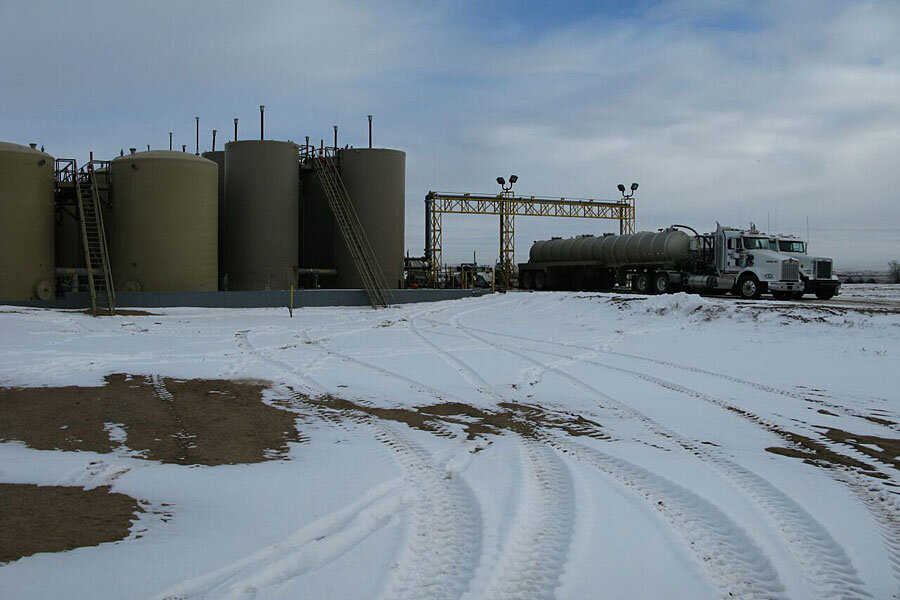Sixfold increase in US earthquakes may be caused by injection wells, say scientists
Loading...
From 1973 to 2008, the United States experienced an average of 21 earthquakes a year of magnitude 3.0 or higher. From 2009 to 2013, there were 99 a year, and in 2014, it jumped to 653 a year.
What changed?
Two studies released today, one in the journal Science Advances and the other in Science point to the same answer: wastewater disposal wells.
These studies arrive on the heels of the Oklahoma Geological Survey's announcement two months ago that it is “very likely that the majority of recent earthquakes, particularly those in central and north-central Oklahoma, are triggered by the injection of produced water in disposal wells.”
The study led by Matthew Weingarten of the University of Colorado, Boulder found that the entire increase in the rate of earthquakes is associated with fluid-injection wells. The study concluded that “high-rate injection wells,” those that injected more than 300,000 barrels per month into the ground were much more likely to be associated with earthquakes than lower-rate wells.
If an earthquake occurred within 15 kilometers of an active injection well, the study considered it to be associated with that well. Prior literature has set the radius at five kilometers. But, as the study notes, there exists a ten-kilometer uncertainty estimate when identifying an earthquake's epicenter. With these figures in mind, Weingarten’s team identified 18,757 wells as potentially associated with earthquakes out of a database of 180,000 wells from Colorado to the East Coast.
Weingarten’s team studied two types of wells: saltwater disposal wells and enhanced oil recovery wells. The team found that the saltwater disposal wells were one and a half to two times more likely to be associated with earthquakes than enhanced oil recovery wells, says Mr. Weingarten, lead author of the study from the University of Colorado.
“Saltwater disposal wells are typically deeper, they are for the purpose of the disposal of wastewater. Enhanced oil recovery wells are for the promotion of oil recovery,” says Shemin Ge, a hydrologist from the University of Colorado, Boulder who is associated with Weingarten’s study.
“The entire rate change that we’ve seen in the last few years is associated with injection wells,” says Weingarten. “We think that’s clear evidence that this earthquake rate of change is not natural.”
“The earthquakes in Oklahoma would have happened eventually,” said Rall Walsh, the author of study from Stanford University, in a press release. “But by injecting water into the faults and pressurizing them, we’ve advanced the clock and made them occur today.”
Mr. Walsh compared plate tectonics to a hockey puck balanced on a table tilted at a 20 degree angle. “Adding saltwater disposal wells to the system is like me telling you that the table is not a regular table, but an air hockey table. The saltwater disposal wells adding pressure is like turning the switch on the air hockey table and now you’re pumping fluid into the interface between the puck and the table,” says Walsh.
Weingarten also notes that there were a number of other factors that could contribute to the susceptibility of an area to earthquakes, including the regional state of stress and the fault orientation to the stress field. Walsh supported this adding, “the important thing to realize is that geology is very different across the US, and so it can vary a lot depending on where the well is. It’s not just the rate in any one well, but it’s the fact that you have so many wells in a relatively small area.”
Walsh’s study focused on Oklahoma and concluded that “Eight percent of Oklahoma’s land area had 27 percent of its saltwater disposal and 71 percent of its earthquakes.” At the same time, his team found areas nearby of comparable size with essentially no earthquakes and no saltwater disposals.
“The Safe Drinking Water Act regulates these saltwater disposal wells, and it does a great job of protecting drinking water, but it was never designed to prevent these wells from triggering earthquakes,” says Walsh.
The permits for well injection rates vary between and within states according to Suann Guthrie, a spokesperson for XTO Energy, a subsidiary of ExxonMobil. XTO Energy currently operates approximately 40,000 wells across the United States including in over 1.2 million acres in Oklahoma.
Both studies point to the need to manage injection rates in order to minimize the likelihood of induced earthquakes in the future.
“Perhaps by monitoring the injection rates we could reduce the seismic risk, and we would benefit from taking certain measures such as if we could better monitor pore pressure within the rock formations because pore pressure is the ultimate culprit in this process of induced seismicity,” says Dr. Ge.
Geophysicist Art McGarr suggests that all the stakeholders in the oil and gas industry share data amongst the community, adding that there is a need for "more comprehensive" networks to monitor seismic activity.
“My hope is that we as a scientific community can provide technical solutions allowing the best of all worlds in a sense. The hope is that we can provide technical solutions that solve the earthquake problem without completely shutting down other viable energy sources,” says Walsh.







